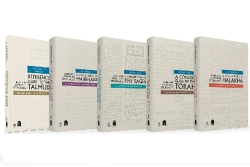I confess that until I finally met him in person, I could not believe that Rabbi Adin Steinsaltz was really just one man. He had published such a huge body of work that I imagined him a crew of people working together under one name.
When he finally came to our community and I got to meet him, I saw that he was really just one person -- a scholar with an impish smile, a quick wit, and an extraordinary ability to bring Torah to people at every level of Jewish learning and across the denominational lines that usually divide us.
Adin Steinsaltz was born in1937 and grew up in a secular home in Jerusalem. His first interest was mathematics, but somehow he found his way into Jewish learning and devoted his life both to serious research in Talmud, Kabbalah and many other areas of Jewish thought and to sharing his knowledge with people everywhere.
A few years ago, for example, he made use of the new technology that makes interactive learning possible to create the World Day of Jewish Learning, a day in which people in almost every country around the world could study the same sources together in whatever language they wished and exchange views on the meaning of these texts.
Rabbi Steinsaltz is best known for his translation and commentary of the Talmud. He did not complete all the volumes of the first English edition (Random House), and later partnered with Koren Publishers in Jerusalem to produce his magnum opus – a 42-volume set of the Talmud, with color images and a new translation.
This latest collection, published by Koren shortly before his death on August 7, 2020, may be his most important work because these 5 volumes encapsulate the basic areas of Jewish learning, including contemporary issues, in a way that is easily accessible to the general reader.
For example, in A Concise Guide to Mahshavah, the volume on Jewish thought, he addresses the question: Where does the Jewish tradition stand on evolution? The answer he gives comes from a teaching by Rabbi Kuk, who argues that evolution, in all its intricate design and complexity, is not a refutation but a proof of the power of the ineffable Creator of the universe.
An example of how he explains the tradition in contemporary terms is found in A Concise Guide to Halakhah. Most Jews have a general idea of the importance of tzedakah in Jewish tradition. What we have rarely seen before, but included in this volume, is a tzedakah calendar listing all the different occasions in our lives that should be celebrated with tzedakah. His approach makes clear that, in the Jewish tradition, giving is an indispensable part of thanksgiving.
In A Concise Guide to the Torah, we read the midrash that tells how Abraham stayed at the very same lodging places both on his journey down to Egypt and on his journey back to Canaan. At first, this seems to be a trivial detail. Do we really need to know that he stayed at the same Motel Six on the way back as he did on the way down to Egypt? But Rabbi Steinsaltz catches a nuance in this passage. When Abraham went back from Egypt he was a rich man, yet like billionaire Warren Buffett, who has remained in the same little house in Omaha, he did not let that change his spirit of modesty and moderation. In those few words, we see a lesson for ourselves in how to make sure that wealth – we should be so lucky -- does not spoil us
Whatever your level of Jewish knowledge or wherever you might be on the religious spectrum, this collection is worth keeping handy, so that the next time someone insists that Judaism says this or that about a certain topic, you can look it up and see if they are right or not.


